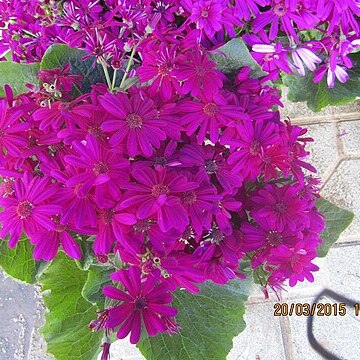Perennial herb, erect or scandent, often climbing, to 1.5 m (scrambler), often 0.6 m tall/long. Stems slender, herbaceous, woody and branching towards the base, glabrous or sparsely hairy or very hairy or cobwebby, glabrescent. Leaves deltoid to deltoid-reniform, distinctly to shallowly lobed, upper leaves often with lateral pinnae below the main lamina, occasionally lyratiform; lamina 10-60(-80) × 11-65(-73) mm, bright green, glabrous or hairy or cobwebby, glabrescent above, usually hairy below especially on veins, or thickly cobwebby; apex acute to obtuse; margin coarsely dentate; base truncate, subcordate or cordate; petiole (5-)11-41(-68) mm long, sparsely or densely hairy or cobwebby; auricles small or large, auriform, coarsely dentate. Capitula few to many in lax corymb or more compact corymbose panicle; peduncles (2-)6-44 mm long, glabrous or hairy and glabrescent, or cobwebby, bracteolate. Involucre calyculate; phyllaries 8-13(-14), 3.5-8.0(-13.0) mm long, glabrous, occasionally cobwebby amongst calyculus bracts; margins scarious, apices sometimes purple. Ray florets 5-8(-13), rarely as many as 16, 4.8-12.0(-16.0) mm long; limb (3.5-)4.0-10.5(-14.0) mm long, 4-veined (-6-veined). Disc florets 14-32(-39); corolla 3.5-5.5 mm long. Cypselae obovate, compressed, margined (to narrow-winged), dark brown (to black), often with paler margin or wing, (1.8-)2.0-3.0(-3.5) mm long, glabrous or ciliate on margins and/or faces to varying degrees. Pappus c. 5 mm long.
Perennial herb, erect or scrambling, 0.6-1.5 m high/long. Leaves deltoid to deltoid-reniform, lobed, upper leaves often with lateral lobes below main lamina, auricles small or large, auriform. Capitula few-many in lax corymbs or more compact corymbose panicles; peduncles glabrous or hairy, glabrescent; involucral bracts 8-13, glabrous. Ray florets 5-8(-13). Disc florets 14-39. Flowering time mainly Apr.-July. Cypselae margined (to narrow-winged), dark brown (to black), glabrous in EC.
Possibly perennial herb, up to 1 m high. Leaves deltoid in outline, thinly hairy below, at least on nerves; petioles auricled. Rays 5 (rarely 6). Achenes glabrous. Flowers bright yellow.

